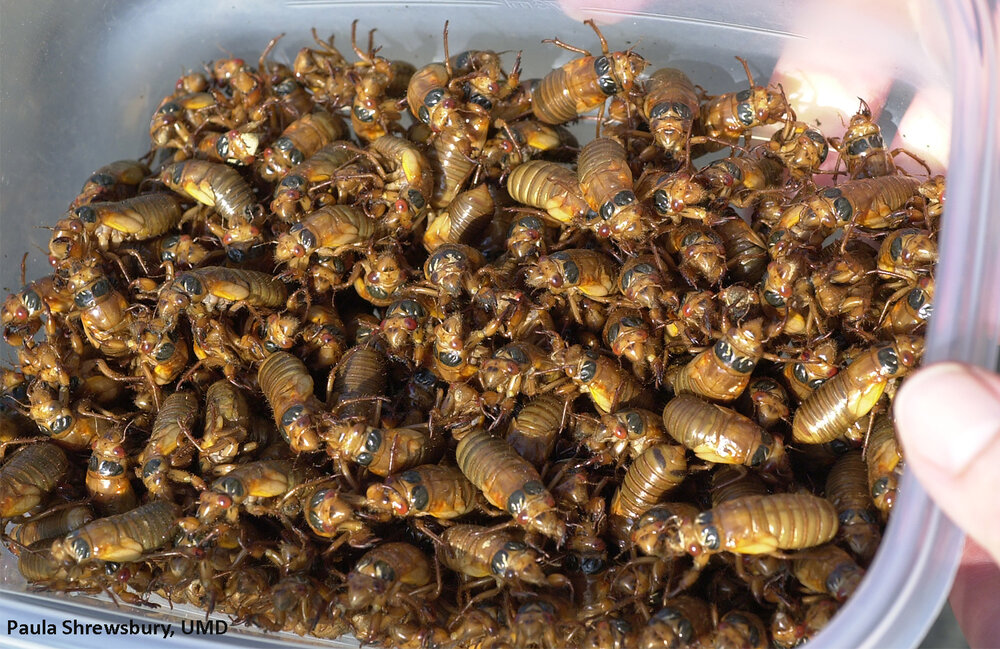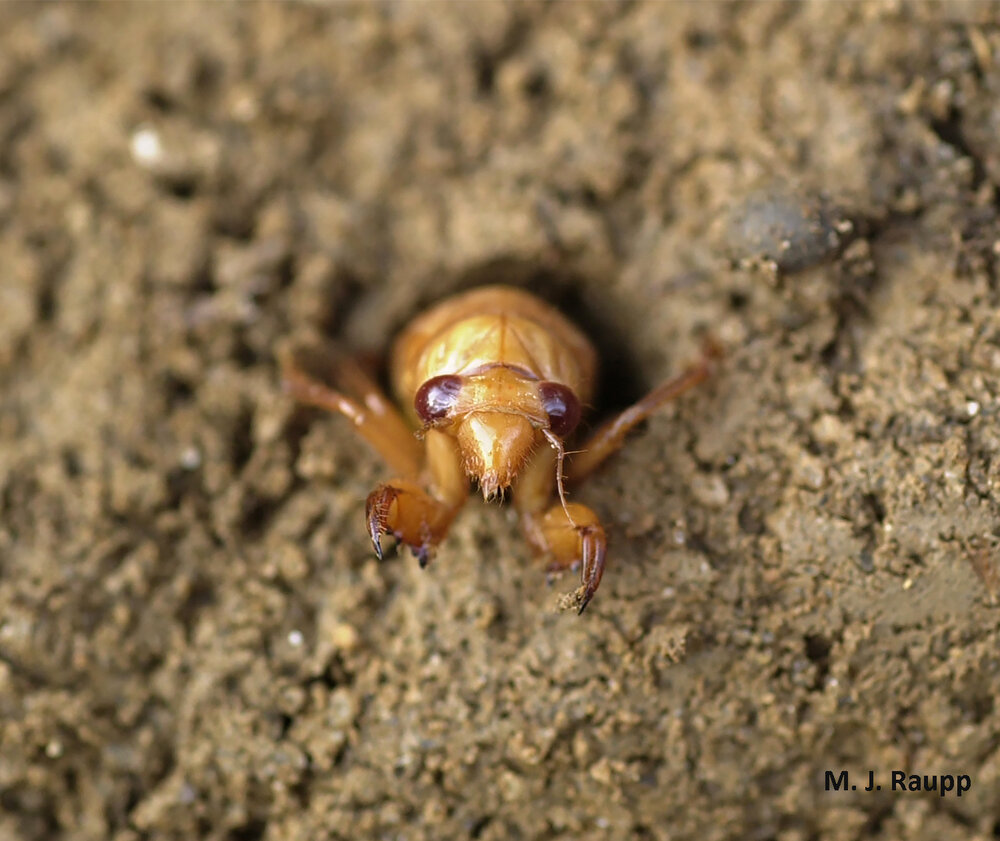When will we see cicadas in the DMV? Appearance of Magicicada spp.

On the day of emergence, periodical cicadas will have black patches on their dorsal surface just behind their red eyes. Image credit: Paula Shrewsbury, PhD
In the past month, we peeked underground to see what periodical cicada nymphs were up to, untangled the misconception that cicadas are locusts, and learned to recognize signs of cicada activity by observing exit holes and excavations in landscapes created by foxes, raccoons, dogs, and other mammals. Recently, the most frequently asked question about periodical cicadas is “when will cicadas appear.” Bug of the Week has been tracking the life history of periodical cicadas for almost two decades so let’s look at some historical data and see what it reveals.

Almost-ready-to-emerge cicadas like this one lack dorsal black patches behind their red eyes.
At the last emergence of Brood X way back in 2004, in University Park, MD, the first cicadas were up and out of the ground on May 6. University Park is a suburb just a few miles from a major urban heat island called Washington, DC. About 20 miles further north in less urbanized and cooler Columbia, MD, the big jail break happened a full nine days later on May 15, 2004 beneath an ancient crabapple tree in my front yard. It is well known that emergence dates of periodical cicadas can vary over relatively short geographic distances due to variation in exposure to the warmth of sunlight on the ground and local temperature regimes. In different locations, soil temperatures hit the magic 64 degrees Fahrenheit on different days. A soil temperature of roughly 64ᵒF is the proximate cue that the world above ground is now warm enough for cicadas to emerge, shed their skin, best hungry predators, climb to the treetops, and begin the awesome task of finding a mate and fulfilling the biological imperative to reproduce.
How can we tell when the big jailbreak is close at hand? The images and video accompanying this episode provide some clues. For the last several weeks, we witnessed almost-ready-to-go periodical cicadas peeking out from their galleries. In these images, notice that just behind its brilliant vermillion eyes, the dorsal surface of the cicada’s exoskeleton is uniformly tan in color. On the evening or day of emergence, notice how the exoskeleton of the cicada bears two jet-black patches just behind its eyes. In more than a dozen emergences of periodical cicadas attended by the Bug Guy, this seems to be the clue that cicada emergence is very close at hand or underway. When you see these dark patches, the big show is about to begin.
For seventeen years, nymphs of Brood X cicadas have been developing underground. While digging a hole in my yard in 2018, I discovered a quartet of periodical cicadas about 14 inches underground. Notice their white eyes and uniformly tan bodies. Last week, a periodical cicada not quite ready to emerge rested at the top of its exit gallery beneath a cinder block. Just behind its red eyes, the dorsal surface of the cicada is uniformly tan. On the evening of its emergence, notice how the dorsal exoskeleton of the fully developed cicada nymph bears two distinct black patches just behind its eyes.
In a previous episode of Bug of the Week in 2017, we reported sightings of impressive numbers of Brood X cicadas that appeared four years early. These cicadas are known as “stragglers.” Stragglers are periodical cicadas that emerge years prior to or after the major portion of their brood mates. Often, 17-year cicada stragglers emerge four years prior to the emergence date of rest of the brood. In 2017, Maryland Brood X stragglers appeared on May 14 in Columbia and Gaithersburg. In addition to emerging four years early, sometimes stragglers emerge one year early and this is exactly what happened in 2020. Using data collected in 2020 from the brilliant Cicada Safari App, the very first cicada out of the ground was seen on April 19, just south of Towson, Maryland. This one was an extreme outlier. Cicada emergence really picked up in the DMV on May 14, and by May 24, 25% of emerging cicadas were out of the ground. By May 28, 50% of cicadas had emerged, and just few days later on May 31, 75% of all cicadas had emerged in DC, Maryland, and Northern Virginia. So, if 2021 is anything like 2020 or previous years for that matter, cicadas will be regularly seen as a trickle in our region in the first two weeks of May with a tsunami hitting in the last two weeks as these teenagers are up and out for the cicadapalooza. Here in the DMV in 2020, the last cicada to emerge was reported on June 14. Due to a normal life span of two to four weeks, don’t be surprised to see adult cicadas alive and well into the waning weeks of June, but, sadly, by the 4th of July, their moment in the sun will be all but finished and nothing but a fading memory. Remember, the great W. C. Fields once opined “Never work with children or animals” and I will add, especially with periodical cicadas, “or when it comes to weather”. When will we see cicadas in the DMV? Perhaps, we will just have to wait and see.
Acknowledgements
Bug of the Week thanks Scott and Jordana Snider for providing the inspiration for this episode. Three cool articles, “Combining data from citizen scientists and weather stations to define emergence of periodical cicadas, Magicicada Davis spp. (Hemiptera: Cicadidae)” by M. J. Raupp, C. Sargent, N. Harding, and G. Kritsky, “The ecology, behavior, and evolution of periodical cicadas” by K. S. Williams and C. Simon”, and “Thermal synchronization of emergence in periodical “17-year” cicadas (Homoptera, Cicadidae, Magicicada)” by J. E. Heath formed the foundation for this episode.
To learn more about periodical cicadas, please visit the Cicada Crew website at the University of Maryland.
This post appeared first on Bug of the Week